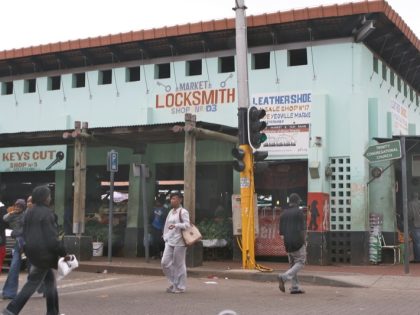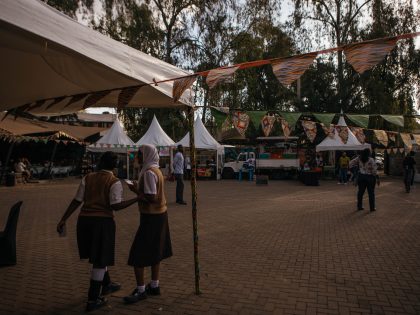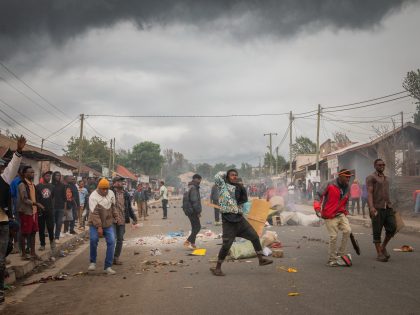Dispatch from Berlin
“What is the difference between refugees and ‘normal’ citizens besides the fact that the former had to flee from their homes? There is none.”

Refugee protest, Berlin. April 2014. Image: Montecruz Foto
In August 1992, a mob of neo-Nazis attacked a hostel for foreigners in the northern German city of Rostock, hurling stones and petrol bombs. The attack lasted for four days, encouraged by an estimated 3,000 cheering spectators. After two days, the police left the scene; the mob then set fire to a building housing Vietnamese workers and their families. The police watched the fire from an adjacent hill.
Over the weekend, a man wielding a jagged-edged knife stabbed German politician Henritte Reker in the neck, citing her pro-refugee policies. Police for now have arrested the suspect – a rare occurrence in Germany where hate crimes targeted at people of color occur frequently and typically end without arrests or prosecution. Last week, a firefighter who broke into a home for asylum seekers and sprayed the attic with gasoline before lighting it on fire walked free. The prosecutor said the firefighter hadn’t intended to hurt anyone.
As evidenced by the Rostock siege, such xenophobic violence is not new; a 2011 Human Rights Watch report noted that the government has recorded 500-650 violent hate crimes each year since 2005. Local organizations that monitor hate crimes and support survivors report much higher numbers. The German government does not publish how many of these cases result in prosecution, but Human Rights Watch found only two examples of successful prosecution of hate crimes during the period covered in the report.
In Berlin, I spoke with people seeking asylum from Syria, Eritrea and Cameroun, as well as advocates and organizers responding to the needs of refugees across the city. Those who had been in the country for a few months all decried one thing: Germany’s institutionalized racism and what they called its accompanying policies of humiliation.
While Angela Merkel has committed to receive significant numbers of Syrian refugees in Germany, effective government support has not followed suit. Media coverage depicts the German system as ‘overwhelmed’ and struggling to cope; yet Germany registered consistently high numbers of asylum applications months before the current “crisis”. (An article in Spiegel Online from August 2013 is titled, “Rage and Refuge: German Asylum System Hits Breaking Point.”) Germany has been slow to implement major reforms to reception policies or find real housing solutions, insisting most refugees stay in state-run camps that are crowded, lack safe spaces for women and prevent inhabitants from participating in society. Refugees in rural areas as well as urban centers fear racist attacks and reprisals.
Meanwhile, temperatures plunged in Berlin, leaving the hundreds of people waiting in line to register their asylum claim at the LaGeSo (Department for Health and Social Affairs) reception center outside in the bitter cold. While Syrian refugees are now granted an appointment number relatively quickly, a two-track system is quickly emerging where refugees from other countries do not receive a number for weeks.
All asylum-seekers face a Kafka-esque system where they are expected to complete paperwork in German and speak German when they meet with government officials. Germany does not provide translators at any stage of the asylum process, and as a result people cited a new black market that has sprung up with people charging fees of around 60 euros to accompany an asylum-seeker to government appointments. Refugees have no way of knowing whether their translator is competent – and determining asylum claims often depend on specific details and the consistency of a person’s story.
The German parliament passed a new law last Thursday reducing benefits for refugees, restricting their freedom of movement for up to six months in government designated refugee camps and declaring Albania, Kosovo and Montenegro ‘safe countries’ – making it nearly impossible for anyone from these places to receive asylum. In response, close to a thousand people in Berlin marched under a gray spitting sky from Potsdamer Platz past the parliament in protest, trailed by German police in riot gear. The marchers shouted the name of Oury Jalloh, an asylum seeker from Sierra Leone who was arrested one night in 2005 and burned to death in a police cell.
The Berlin Refugee Movement – a decentralized collective active since 2012 – just published a Refugee Guide to Berlin, aimed at providing recent arrivals with necessary information to be self-sufficient. The Guide covers where to find emergency food, shelter and medical care. It also asks, “What is the difference between refugees and ‘normal’ citizens besides the fact that the former had to flee from their homes? There is none.”



















